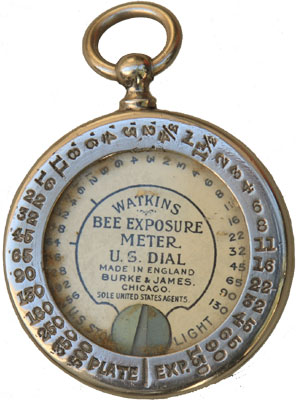
|
  Maker: Watkins Model: Bee Circa: 1907 Price (new): $1.25 Measure Type: Incident Measure Cell: Printing-Out Paper |
|
Some people used POPs for direct light measurement. Watkins made this little watch-case, filled it with discs of POP, and topped it (under glass) with a little wedge-shaped aperture. When you were ready for exposure, you'd rotate the back slightly so that a sliver of unexposed paper was uncovered. Then you take hold it under the same light that illuminated the subject, and count the seconds until the paper turns a shade of gray that's between the wedge sides (the left side is a bit lighter than the right side). "Judgement is greatly aided if the instrument is held at arm's length and the eyes half closed." [italics are theirs, not mine.] So now you know the seconds. You pick an ƒ/stop that you want to work at, let's say ƒ/16. You look up the film speed on a chart. Let's say I'm using Kodak Extra Rapid, which is rated at 180. I put my thumb on the dial glass and pinch it down snugly against the case back, and I hold the stem of the case stem with my other hand, and I rotate the case-back/dial-glass/POP until ƒ/16 matches up against 180 on the left side. Then I look on the meter's right side, and those are my ƒ/stop shutter combinations. For this example, I would use ƒ/16 at ½ second. One of the tricky things about this meter is learning to read the outer dial. It begins at the 5 o'clock position (in the photo here) in full seconds and gets shorter as we move counter-clockwise. Around noon we move into fractions of a second, so this thing tops out at 1/500th of a second shutter speed. According to the instructions, you can convert to minutes as well. There are two manuals that I know of on the internet. Mine is the 7th edition (click on the pdf icon above) and has data for American films and cameras (including Kodak's uncalibrated ƒ/stops). There's also this 12th edition from an excellent Weston meter site. Their edition is British and more recent than mine (apparently post World War I). There's also a little more info at the wonderful BoxCameras.com site. Roger Hicks has a 17th edition on his website. Two companies made these things and they're very much alike. Wynne made the Infallible, and Watkins made Bees in Hereford, England. Mine was imported by the famous outfitter Burke & James out of Chicago, so there's a bit of co-branding, plus mine is calibrated for US speeds and films rather than British. One of the neat things about this meter is that they could recalibrate it simply by printing a new face card. According to later literature, you could buy different cards depending on your needs (like a Studio version). It appears that Watkins named this the "Bee" because another of his interests was beekeeping. Figuring out the age of this has been tough, since they didn't date any of the literature (that I've found, anyway). They made these things for years; the original came out around the mid-1890s and wasn't fully obsolete until the 1930s when photo-electrics came out. And they continued to make and sell them long afterward because photo-electrics were expensive. Figure a Weston Master was $30 in 1940, which was the same price as a decent camera) and these things were $1.50 or so. For depression-era amateurs, a Bee was very affordable. That said, considering the cameras and films listed in my instruction book, I've dated mine to around 1907. |
|
©opyright by James Ollinger. All Rights Reserved.
Company names and models are registered trademarks of their respective owners
and are not affiliated with this website in any way.

sm.jpg)